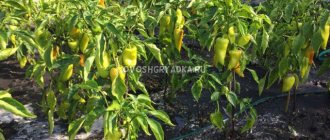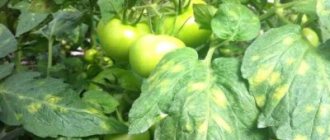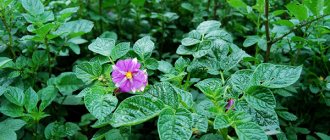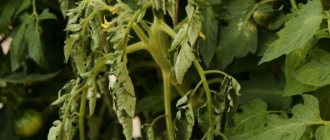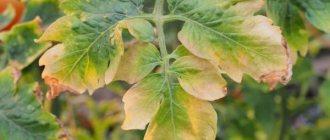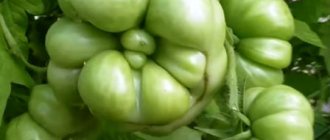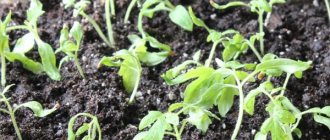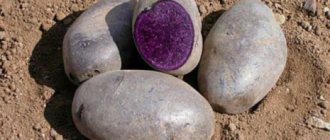All gardeners need to know why the leaves turn this color and what needs to be done.
The article describes in detail what causes certain changes in the color of leaves and stems, as well as ways to combat ailments.
Why do the foliage and stems of tomatoes change color?
Every plant contains pigments - coloring substances “anthocyanins”. Because of them, red, blue, or shades obtained as a result of mixing these colors appear. The color of diseased shoots changes gradually, first from below. An inconspicuous lilac or pink tint appears, which turns into purple.
If no action is taken, the leaves will turn bright purple or blue. They also curl. The stem becomes hard and brittle, and the fibers on it become coarser. Tomatoes weaken and wither. Next we will look at why this happens and what tomatoes lack, the leaves and stems of which change color.
Phosphorus deficiency
The lack of this component is dangerous during the development of roots and the appearance of the ovary. Tomatoes require 5 times less phosphorus than nitrogen. With this mineral:
- growth energy is provided;
- sugar content increases;
- high-quality fruit pulp is formed;
- productivity increases.
Tomatoes accumulate phosphorus and gradually use it up throughout the season. If there is a lack of this microelement, tomatoes will grow worse and bloom later. And if the fruits set, the weight will gain slowly and they will not ripen for a long time.
Seeds from these fruits cannot be collected. This is due to the fact that with phosphorus deficiency in tomatoes, nitrogen is poorly absorbed. Therefore, plant development stops and the fruits become small.
Bushes that have enough phosphorus tolerate cold weather more easily, and they are also more resistant to disease. They have a strong root system. The fruits can be easily transported and are resistant to damage. Therefore, if there is little phosphorus in the soil, fertilizing is required. And with a lack of this mineral, the leaves turn blue or purple.
Low temperature
It must be taken into account that the absorption of phosphorus at low temperatures is poor. If the soil temperature drops to +12 degrees and the air temperature to +14, then this mineral will not reach the tomatoes.
Cold weather can lead to impaired growth of tomatoes and the appearance of purple stems and leaves. Tomatoes are heat-loving plants that need a temperature of at least +20 degrees. Fruits absorb phosphorus poorly even at elevated levels (+40 degrees).
Unsuitable soil
Nightshades are demanding plants that require balanced soil. A deficiency of valuable components leads to their death. Tomatoes require several important components:
- magnesium;
- potassium;
- nitrogen;
- zinc.
A deficiency of any substance negatively affects the growth and productivity of the plant. An imbalance in the mineral composition of the soil can be detected by looking at the tops: when phosphorus is deficient, the lower foliage suffers. And a lack of magnesium affects young leaves at the top.
The blueness of seedling stems at the base may indicate an overdose of manganese during soil disinfection. In some cases, these are characteristics of the variety or hybrid.
Seedlings may turn purple due to the large amount of alkali in the soil. For tomatoes you need neutral or slightly acidic soil. Due to the large amount of acids and alkalis, liquid phosphorus fertilizers take on a solid form and therefore do not have the desired effect.
Lack of light
Plants require sunlight for normal development. Tomatoes develop normally if the illumination is at least 10 hours a day. With short daylight hours, the leaves may turn purple.
Daylight hours should be no more than 12 hours. Excessive lighting also negatively affects the culture, just like a lack. Tomatoes, seedlings and adult plants require rest as nutrients are absorbed in the dark.
What to do, how to help
Having figured out why the leaves have acquired an uncharacteristic color and the plants have slowed down, they are given help.
The air temperature in the room where the tomato seedlings are standing should be 20-22 degrees. It should not fall below 18 degrees. Any temperature changes, a cold window sill or floor can cause the leaves to change color.
To keep the temperature at the same level, you can install a thermometer next to the plants, and place foil between the window and the seedlings. It will protect from the cold and provide additional lighting. For additional heat, you can place an electric heater at a short distance from the plants until the temperature returns.
At the end of the heating season, to protect against temperature changes, plants can be transferred to a greenhouse if possible.
If there is a lack of light, they are provided with additional illumination with a phytolamp or fluorescent lamp. When placing seedlings on a windowsill, choose the light and warm side.
A few days later, after the restoration of thermal and light conditions, the plants acquire their normal color, their growth and development are restored.
If the reason for the color change was not due to changes in temperature and lack of light, but due to a lack of phosphorus, the seedlings need to be fertilized. To do this, take any fertilizer containing phosphorus in its composition.
When choosing a drug, you need to choose the composition that contains the minimum amount of nitrogen. Its concentration in the soil increases significantly due to a lack of phosphorus, which also negatively affects plants.
- For feeding, take 100 grams of superphosphate per bucket of warm water. The solution is introduced during watering.
- For severe symptoms, take 250 milliliters of superphosphate, which is diluted with 1 liter of boiling water and infused for 10 hours. After which the seedlings are watered with the prepared solution.
- Phosphorus is also found in nitrophosk, ammophosphate, double superphosphate, potassium monophosphate, as well as humate and bone meal. Fertilizers are applied in accordance with the dosage.
The amount of feeding is calculated in accordance with the growth of the seedlings; the higher it is, the more solution is required. For one adult seedling, 0.5 liters of fertilizer is taken.
However, you cannot overdo it. An excess of nutrients for tomato seedlings is just as harmful as a lack of them.
If the reason for the appearance of purple color on the plants is waterlogging of the soil, watering is reduced, the soil is carefully loosened, if it becomes waterlogged, the plants are transplanted into new soil.
If the reason is a lack of moisture, then in hot weather the beds with tomato seedlings need to be covered with protective material. This procedure is carried out until the seedlings gain strength and begin to actively grow. After watering, the soil is covered with a layer of mulch, which allows moisture to be retained in the ground for a longer period.
If the soil begins to crack, then water must be added in moderation, otherwise it can damage the roots of the plants.
If the cause is a cat that is not toilet trained, the seedlings should be placed in a place inaccessible to the animal. It will be impossible to save the tomatoes after he has marked the territory.
Tomato seedlings are purple, what to do: video
Purple spots over the entire surface of the plate
Purple leaves are not the norm. The reason may be unsuitable soil, lack of light, temperature violations, or phosphorus deficiency. But this usually happens when the soil is unbalanced. Whatever the reason, this leads to the plant having a diseased appearance. You should not expect a rich harvest from such plants.
If purple spots appear, it is advisable to spray them with water-soluble superphosphate. The procedure should be carried out in the morning or evening, when there is no strong exposure to the sun's rays.
Mistakes when growing tomato seedlings at home on the window
Tomatoes are responsive to heat and light, but do not perceive drought, disturbed temperature conditions, lack of light or moisture in the soil, which negatively affects the appearance of the bushes and their health.
If the tomato seedlings are not successful, the leaflet for vegetable growers will tell you what to do. To save young seedlings you will have to perform some actions:
Improve lighting. Lamps that illuminate the sprouts in the morning and evening hours will help with this.
- The following technique will help to minimize the elongation of seedlings: free the lower section of the stem from a couple of leaves and sprinkle with soil.
- Transplant the seedlings into fresh air and deepen them down to a couple of true leaves. This will help correct the situation.
- If it is necessary to inhibit the growth of tomatoes, picking helps - moving plants in order to expand the feeding area useful for them.
- To avoid oversaturation of the soil with water, watering should be done based on the drying of the soil. Excessive drying out of the soil should also not be allowed.
- If the bush has grown strongly, this can work to your advantage - you can grow 2 bushes from it. Why is the stem cut between 5 and 6 leaves? The top is lowered into water and the roots are waited for growth. Afterwards it is planted in the ground.
- Using the drug Atlet will help slow down the growth of seedlings. Feeding with nitrogen supplements helps stop their elongation.
- If necessary, a growth stimulator - Zircon, Epin, Energen, Fitosporin - will help to “revive” tomato bushes. The stimulant contains active biological substances that improve seedling immunity and stimulate metabolic processes.
It is now known how to revive tomato seedlings using the most reliable techniques. The main thing is not to forget about phosphorus, potassium and other substances important for the growth of tomatoes.
Blue-green tint only below
This is a sign of a lack of nutrients:
- magnesium;
- potassium;
- nitrogen;
- zinc
Lack of components slows down growth and reduces yield. Deficiency can be determined by the tops. Usually the purple color on the bottom of the leaf appears due to a lack of phosphorus.
If this problem occurs, you need to spray the leaves with water-soluble superphosphate. The procedure is carried out in the morning or evening, when there are no bright rays of the sun.
We invite you to watch a video on how to help tomatoes whose bottom part of the leaf has turned blue:
Why do tomato seedlings turn yellow?
Tomato seedlings turn yellow and grow poorly - this is a serious problem, but the situation can be corrected. If yellowed tomatoes grow at the dacha in protected soil conditions, then the yellowing of the foliage may be due to short-term night frosts
If we are talking about seedlings that are grown at home, then you should pay attention to the following points:
- planting density;
- lack of land in the container for seedlings;
- excessive soil compaction around the roots;
- insufficiently nutritious soil mixture;
- lack of nitrogen;
- diseases of tomato seedlings.
In case of dense plantings, it is better to thin out the seedlings and remove weak plants that are stunted in growth. The lack of soil in the seedling container is eliminated by picking the plants into larger cups. It is better to cover tomato seedlings in areas with cold climates under film at night. This will protect the plants from night frosts. The application of complex fertilizers will provide the plant with minerals.
Why are tomato seedlings purple and growing poorly?
The stem of the seedling often turns purple, and the plant itself grows poorly. What is the reason? Botanists attribute this to a lack of phosphorus. There may be a sufficient amount of this microelement in the soil, but the roots do not absorb it well due to the cold weather.
It has been noticed that at temperatures below +14 degrees Celsius, phosphorus is practically not absorbed by the root system. After warming, the situation will return to normal. If the seedlings grew in a warm environment and there is a suspicion that the reason is that the plant acquired a purple color in phosphorus-poor soil, then tomatoes are treated with the following drugs:
- superphosphate;
- diammophos;
- potassium monophosphate;
- nitrophoska.
Tomato seedlings turn yellow: chlorosis and its treatment
Chlorosis is a common disease of tomato seedlings and many other plants. With this disease, photosynthesis in the leaf slows down, which leads to a decrease in chlorophyll production. In practice, the vegetable grower notices that the tomato leaves turn yellow, but the veins remain green. The main causes of chlorosis include:
- Damage to seedlings by fungi, viruses or bacteria.
- Stagnation of moisture around the roots or damage to the root system.
- Poor soil composition.
- Lack of microelements in the soil.
In connection with these reasons, a distinction is made between infectious and non-infectious chlorosis, which develops as a result of violation of the rules for growing seedlings and caring for them. Only a specialist can determine the exact cause of seedling disease after conducting a comprehensive laboratory study.
The photo shows chlorosis of tomato leaves
The main symptoms of chlorosis include the following:
- Shrinking, curling, falling leaves.
- Slowing seedling growth.
- Drying of flowers and fruits.
What can a summer resident do to save tomato seedlings? Here are some tips:
- eliminate mineral starvation using complex fertilizers;
- organize good soil drainage;
- comply with agrotechnical rules for growing seedlings.
The following drugs are used to treat tomatoes: “Ferovit”, “Iron Chelate”, “Antichlorosis”. Tomatoes growing in a greenhouse are affected by the mosaic virus. The symptoms of the disease are very similar in appearance to chlorosis. The pathogen is carried by ticks and insect pests. The drug “Afidol” is effective for treating tomatoes. It is worth resorting to seedling treatment if all other methods of treating tomato chlorosis have been unsuccessful.
Tomato seedlings suffer from chlorosis, what to do, video:
Why do tomato seedlings grow poorly, turn yellow and fall? Determining the cause is not always easy, but if you know the symptoms of mineral starvation of plants, you will be able to eliminate all the symptoms of lightening of tomato leaves. It is worth inspecting the plants for damage to chlorosis or mosaic virus. Usually, the application of complex mineral fertilizers allows the summer resident to solve the problem. How did you treat the tomatoes when their leaves turned light green and curled?
Purple stem
It appears when there is an overdose of manganese, which is used to disinfect soil. Sometimes this is a feature of the variety or hybrid. Another purple stem appears when there is a lack of phosphorus.
The deficiency can be eliminated by spraying with water-soluble superphosphate. The solution should have a concentration of 1%. Spraying is carried out in the morning or evening, when there is no bright sun.
How to grow healthy tomato seedlings at home: 6 top tips
Purple leaves appear on the bottom of young tomato seedlings if the gardener does not follow the recommendations for growing them. There are certain rules that minimize the risk of any problems with the crop and ensure the production of healthy, abundantly fruiting plants:
- optimal light regime - the plant should be kept under lamps in the morning and evening, be sure to turn off the equipment at night;
- You can avoid pulling the seedlings if you remove several lower leaves and bury them;
- if it is necessary to slow down the growth of the crop (so that the seedlings do not outgrow), pick 1-2 times;
- Watering is carried out only as the soil dries; the soil should not be allowed to dry out;
- to accelerate the growth of seedlings, it is permissible to use preparations such as “Athlete”;
- treatment with any growth stimulator will be useful during periods of formation of two true leaves, picking, and planting in open ground.
You should not be afraid of the appearance of a purple color on the leaves of tomato seedlings, because this is not always a sign of disease or poor care.
If you act correctly, the condition of the plant will quickly normalize, its appearance will become natural, and the previous change will not affect the yield.
Elena Vasilyeva
Leaves change color and curl
This occurs when there is a nutritional imbalance. The color and shape of the leaves change, and deformation is observed. Such signs appear both with an excess and with a deficiency of microelements. This is not the norm, so timely help is important.
It is necessary to develop a suitable nutrition system in which all the necessary elements will be introduced during watering. Some valuable components are added with fertilizers. Timely help consists of fertilizing with organic matter and stove ash.
What measures should be taken if tomato leaves change color?
As soon as you notice the first purple leaf on one of the tomato bushes, immediately begin saving the plantation. If you postpone this matter until better times, the process will become irreversible, and this year you will have to buy tomatoes, rather than pick them from your own beds.
First of all, you must make sure that the temperature in the greenhouse is comfortable for the tomatoes. If the temperature regime does not correspond to what the tomatoes need, then immediately bring it back to normal, and the seedlings will thereby be saved. It doesn’t hurt to water the seedlings with warm water.
If the temperature in the greenhouse is normal, immediately fertilize the soil with phosphorus fertilizers.
If purple spots appear on tomatoes already growing in open ground due to cold weather, then cover the beds with film and let it remain until warmer days arrive.
When tomatoes are cool, there is no need to feed them. It’s better to wait until it warms up and then feed the plantation.
Olga Danilina
Causes of problems in the greenhouse
In greenhouse conditions, the purple color appears when the temperature regime is violated. Tomatoes need a temperature of at least 20 degrees. If the air is colder, it will stop the development of plants. But heat above 40 degrees leads to the same effect.
At low temperatures, plants in the greenhouse require heating. It is enough to close the doors and windows and pour warm water. Installation of heating devices is allowed. If the tomatoes are outside, they are covered with film.
Why don't tomato seedlings grow?
IngaMus
Usually, seedlings may not grow well due to bad seeds, maybe even expired.
Another important factor is land. I always plant in a ready-made soil mixture, which is sold in the tomato store. Of course, taking land from the forest would be even better, but that’s only if there is such an opportunity.
The third reason is the availability of sufficient light. It also has a very strong effect.
And of course, when watering, you must not overdo it, but also not dry it out.
Temperature is also important, but I doubt that it’s so cold in your apartment that the tomatoes don’t grow; most likely, some of the previous reasons are at play.
Esther
If tomato seedlings do not grow, then perhaps they do not have enough light, heat or watering. It may also be thickened and lacking nutrients. It is necessary to plant the seedlings so that they have a lot of soil, water them well regularly and add light at night. You can also water the seedlings with superphosphate.
Jennyfer
When assessing the condition of tomato seedlings, several factors need to be taken into account:
- Lighting - tomatoes love sunlight; they should not be deprived of this main source of growth.
- Moisturizing - watering should be moderate but regular.
- Temperature - excessively low temperatures inhibit the growth of seedlings, optimally 20-23 degrees.
- Soil nutrition - if the seedlings have withered and turned bluish - there is not enough phosphorus, if the stem turns yellow and thinner - it’s time to feed it with nitrogen.
dolfanika
The reason may be due to insufficient nutrition.
If the stems and leaves of the seedlings are stunted, thin stems, small pale leaves, then there is not enough nitrogen in the soil
If the underside of the leaves turns red-violet, then there is not enough phosphorus
A lack of potassium is indicated by yellowness along the edges of the leaves and their curling.
With a lack of iron, tomato seedlings stop growing, the leaves become yellow and discolored.
If the picking was done incorrectly, the seedlings stop growing due to damage to the roots.
There may not be enough oxygen and the soil may not be suitable.
And seedlings may be susceptible to diseases if a lot of water was poured at an insufficiently warm temperature. Then the roots must be washed in a weak solution of potassium permanganate and transplanted into fresh soil
And seedlings also begin to develop poorly if they are infested with pests - wood lice, spider mites, earwigs. Then the seedlings urgently need to be treated with phytoverm
lerales
I can list the reasons why this happens:
- First: bad seeds;
- Second: it’s cold, tomatoes love warmth;
- Third: the seeds are planted deep and they take a long time to germinate; a lot of effort goes into germination.
- Fourth: you need to water it once every three days, or even four, so that the soil is moist, but do not overwater them; tomatoes do not like a lot of water.
- Fifth: bad soil, for seedlings you need to take soil in the forest under the trees.
- Sixth: you need to add urea to the seedlings when they get a little stronger.
If you comply with all these conditions, then you will have excellent seedlings.
alex-rib-87
Because the tomato needs freedom. Make sure they are not cramped. First they plant in rows, and then transplant (dive, if I’m not mistaken) into a more convenient container so that they can grow wider
It is also worth paying attention to the air temperature and the presence of the sun so that the earth warms up and is warm. The soil must also be nutritious
It may be that you have low-quality seeds with low germination.
Edward
There are several reasons why tomato seedlings do not grow. The most common reason is poor seed quality. It is better to buy those that are in demand or on the advice of friends. Also, do not forget to water the seeds, they love moisture. Monitor the temperature and proper seating. You can ask advice from people more experienced in this regard.
elena-kh
Perhaps the seedlings are not getting enough sunlight. I also once planted some of the seedlings on the windowsill, and some of the seedlings on the table. So, what was on the windowsill grew perfectly, but the seedlings that were on the table did not have enough sunlight. And nothing appeared beyond the cotyledon leaves.
ValentinaK
There may be several reasons, but one of the most common is heavy soil. When I started gardening, I thought it would be better if I took black earth soil. but it’s all crumpled up, the roots are weak and there’s no strength to draw out nutrition. I had to dilute it with sand later.
crist
You need to know that at a temperature of 14-15 degrees, tomatoes stop growing. Very often this factor is the cause, but there may be others. May depend on soil composition. Feeding is already required here.
bolshoyvopros.ru
What to do if tomatoes take on such shades?
There are several ways to improve the condition of tomatoes. Which one to choose depends on the reason for the appearance of the blue or purple tint.
Control of temperature and lighting mode
Seedlings are usually left indoors. There should be a temperature of 25 degrees. After the emergence of seedlings, the indicator is reduced to 20 during the day, and to 16 at night. If a purple color appears, the seedlings are transferred to a warm room.
In case of insufficient lighting, seedlings are moved closer to a source of natural light. Phytolamps will also help, especially at the beginning of development. Daylight hours should be 10–12 hours.
Fertilizer application
The lack of phosphorus is compensated by watering with solutions of phosphorus fertilizers. Fits:
- superphosphate;
- ammophos;
- nitroammophos;
- nitrophos.
Any product should be diluted according to the instructions specified by the manufacturer.
Wood ash is effective. It is simply scattered over the soil in which tomatoes grow, or a solution is prepared. You will need ash and hot water (1 liter each). After infusion for 24 hours, you need to add warm water (3 liters) and laundry soap (15 g). The liquid is used to spray plants.
Soil preparation
Seedlings are grown in light, fertile and loose soil. Universal primer is suitable. It contains all the necessary components, including phosphorus. Such soil ensures normal development of the plant.
How to properly prepare and carry out phosphorus fertilization
How to feed purple tomato seedlings and how much fertilizer to take:
- Conventional superphosphate for cultivated areas requires 50 g per square meter, 500 g per square meter. The method of application is watering or embedding granules with digging.
- Double superphosphate needs 30 - 40 g per meter. When feeding into a hole - 10 g, mixing with the bottom layer of soil.
- Bone meal in the fall will require from 100 to 200 g per square meter. It also depends on the variety - low-fat flour contains 35% phosphates, regular flour - 15%.
- Phosphorite flour is suitable for acidified soils. Apply 200–300 g of the substance per hundred square meters of land. If you overdo it, there won’t be any special problems, because the minerals dissolve gradually, so its effectiveness in the first year is only 30%.
For foliar feeding of tomato seedlings, it is recommended to use only superphosphate, since it contains potassium and nitrogen, as well as sulfur and calcium, that is, it has a complex effect. The disadvantage of foliar spraying is that sediment forms at the bottom if the granules are filled with cold water, so the 2% solution is infused for a day. In 15 minutes you can prepare the fertilizer by pouring boiling water over the granules. The cooled solution is sprayed on the top and bottom sides of the sheet, since the bottom contains fibers that absorb liquid. The event takes place in the evening after sunset.
Advice from experienced agronomists
Effective measures will help prevent problems when growing tomatoes:
- Soil made from humus, peat, garden soil and river sand helps. This is a balanced mixture.
- Moisture-loving tomato varieties are negatively affected by foliar watering. Roots require moisture.
- The quality of illumination depends on the density of plantings. There should be a distance of 1.5–2 cm between the seedlings. Then they are picked, transplanted into separate pots.
- Light should be maintained for 12 hours.
- Timely fertilizers will help prevent starvation.
If the leaves and stems of tomatoes turn purple, the reasons usually lie in violation of the growing rules. Nutrition deficiency, improper lighting, unsuitable soil and low temperatures are the main factors that change the color of green mass. When a problem arises, it is important to take effective measures in a timely manner. It’s even better to prevent this from happening through prevention.
Consequences of early flowering
The slight appearance of buds and flowers will not cause much damage to the gardener. Of course, it all depends on the specific situation.
If tomato bushes are grown in individual containers, and planting in open ground will take place by transshipment, then the presence of flowers and even ovaries is acceptable. In this case, the plant’s adaptation time to new conditions will increase, and the first fruits will not fully meet the varietal qualities.
It is much worse when overgrown and weak seedlings bloom. She herself needs help when planting, so it is wiser to pick off the flowers on such bushes.
You should always remember that many tomato varieties have a limited number of flower clusters and each torn inflorescence leads to a decrease in yield.
To avoid the sad consequences of early flowering seedlings, you need to follow the recommendations of experienced gardeners and then the tomato harvest will be generous and of high quality.
Fertilizer application
When the temperature is okay and the leaves are purple, there is a high risk of:
- phosphorus deficiency;
- the presence of the mineral in an insoluble form.
If purple veins appear on tomato leaves, what should you feed them with? To correct the situation, complex mixtures and solutions are used.
| Name | Peculiarities | Preparation |
| Potassium monophosphate | Suitable for irrigation and watering during the first and second feeding | Dilute 7-10 g per 10 l |
| Nitrophoska | Water in the first feeding | 10 tsp for 1 bucket of water |
| Natural natural ingredients | Do not overfeed | Humates Thyme Hawthorn Bone meal Prepare compost substrate |
| Double superphosphate | Complements regular feeding | 25 g per 1 m2 sprinkled at the trunk |
| Superphosphate | Foliar irrigation | 1% solution |
| Superphosphate | Do not combine with nitrogen mixtures If there has been preliminary liming, use no earlier than after 30 days | 250 g dissolved in 1 liter of hot water Dilute to a volume of 10 liters |
| Ammophos | Required during the flowering phase | Dilute in heated water, bring to total volume |
| Ammofoska | Mixes with soil | 2 tbsp. mixture into the hole while planting seedlings |
Fertilizers in the form of granules are poured directly into the root zone. It is useful to introduce them into the plot during autumn plowing.
Phosphorus that has been in the soil for more than 3 years has the best digestibility.
Soil preparation
A plot for tomatoes is arranged in places where predecessors such as:
- carrot;
- onion;
- zucchini;
- pumpkin;
- herbs and spices.
To prevent phosphorus from passing into insoluble form, the soil in the beds is limed. For this use:
- lime;
- chalk;
- dolomite flour.
Be sure to increase fertility with organic matter - humus, compost. Autumn green manures are planted - mustard, winter cereals.
Agrotechnicians advise using EM crops. From available funds you can purchase
- Baikal EM
- and Bokashi.
